AC72 Lessons Learned:
Oracle Team USA Moves Forward After Disaster
December 3, 2012
 |
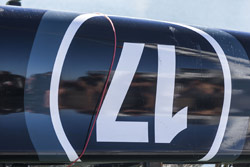 |
 |
|
Photos:©2012 Guilain Grenier/Oracle Team USA |
||
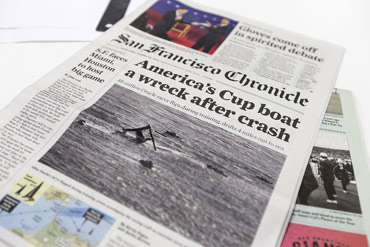 |
|
|
Photo:©2012 Guilain Grenier/Oracle Team USA |
Oracle Team USA engineer Dirk Kramers thought he had seen it all in five America’s Cup-winning campaigns. But nothing compared to the drama that played out in San Francisco Bay on October 16, as he watched the team’s new AC72 catamaran pitchpole in big wind and drift out to sea in pieces just weeks after being launched.
Instead of watching the calendar while monitoring the restricted 30 days of testing allowed for each boat, Kramers and his team have to re-engineer the injured USA 17 while at the same time the team’s second boat completes the build process.
Kramers looks back on that fateful day in October, lessons learned, and what it means for the team. CupInfo also asked Kevin Shoebridge of Emirates Team New Zealand how the Kiwis have adapted as a result.
Aftermath
Many who watched the drama play out on live local television or the internet questioned Oracle Team USA’s decision to take the AC72 out in such difficult conditions on only its eighth day of testing. Hindsight is always 20/20, especially 630,000 YouTube views later looking back on wind gusts to 25-30 knots or higher and an ebb tide of more than seven feet.
“What made life a lot worse for us is that we capsized in the second biggest tide of the year and we got swept out,” Kramers said. “At first, when we capsized, we looked around and thought, 'Okay, we’ll wash up on Alcatraz.' The next thing, you look up and realize you’re going the other way. Within an hour, we were outside the Gate. The wave action outside the Gate is what did in the wing.”
USA 17 ended up in an area known as the “Potato Patch” -- a shoal on Four Fathom Bank outside the Golden Gate. The Patch made short work of the cat’s massive hard wing and sent the team on a fishing expedition to bring home as many pieces as possible. Just where some of those pieces ended up will undoubtedly become local legend.
“The next day, we went out to try and retrieve all the little bits and pieces that were still floating around out there, just to clean up after ourselves the best we could,” Kramers said. “Someone picked up a three-foot section on a beach somewhere, but they were associated with Artemis, so now it’s in the Artemis compound -- we didn’t get that one back!”
Lessons Learned
Until it happened, no one knew exactly how a rescue operation of this magnitude would unfold -- after all, no sane person would capsize a brand-new 72-foot catamaran just to test righting maneuvers. But once the crew was safe, the team had a wealth of facts where they previously had only theory.
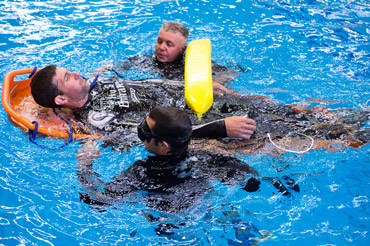 |
|
|
Emirates Team New Zealand practices crew recovery in the pool as
Rescue paramedic Calvin Hicks and Jeremey Armstrong come to the aid of
Derek Seward. |
“We obviously learned a lot about what to do and what not to do with this little exercise -- and these are things we will share with the other teams, because it’s a question of safety,” Kramers said.
“First and foremost, you have to take care of the people. Second is how to deal with the righting, and making sure you have actions and methods to deal with every version of the capsize -- you can capsize and lose your wing right away and that’s a whole different recovery situation than capsizing with the wing staying intact. And there’s a different scenario, with both bows in, which is the way we ended up, or just on your side. So you need to develop recovery schemes for each of these scenarios. In the aftermath of this incident, we’re working on those and we’ll be sharing our recommendations and lessons with the other teams.”
Emirates Team New Zealand has been trialing their new AC72 in the Hauraki Gulf near Auckland, accumulating more days on the water with an AC72 than any other team to date.
Kevin Shoebridge, Chief Operating Officer ETNZ, says his team is trying to learn from the experience of the defender, too. “We have looked closely at the Oracle capsize video. Once there’s water in the wing, the chances of righting the boat are limited,” said Shoebridge. “We are looking at ways of preventing that. Keep the boat floating and wing from sinking and there's a good chance of righting it.”
“We have concentrated on the people … knowing what to expect and how to deal with any given situation. Each crew member has a breathing apparatus strapped to their back. If they are ever caught, tangled, or trapped under the trampoline they have quite a few minutes of air, and they each have a knife strapped on their shoulder to cut their way out.” Training in a deep dive pool, including the reserve air, is intended to help sailors and rescue crews prepare (see video).
“We are also instituting a buddy system so that in event of a capsize if you're okay -- find your buddy and check he's okay. And every sailing day, two paramedics are on the main chase boat. They are trained divers and are ready to go into the water and get to the platform as a first response.
“We have developed a comprehensive management plan that is run from Chase 1 (the big chase boat).” Shoebridge said. “That's where decisions will be made about the rescue and recovery operation.”
Rod Davis, ETNZ Afterguard Coach, blogging about the Oracle capsize, noted that every second counts when trying to minimize damage to the boat.
“Once the people are under control the focus changes to the boat,” wrote Davis. “Oracle’s wing survived the initial impact, but the boat was sitting nose down, making it hard to right. Somehow they got the boat on its side and attempted to right it. We think there is a window of about ten minutes after a capsize when there’s a good chance to right the boat. After that chance of righting falls dramatically.”
Kramers shares those assessments, but also knows firsthand nothing is as simple as it sounds.
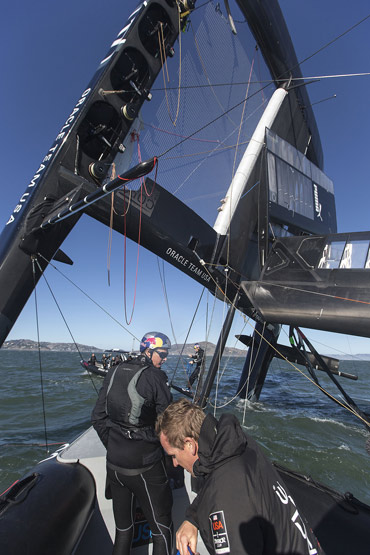 |
|
|
Photo:©2012 Guilain Grenier/Oracle Team USA |
“Righting it immediately is one thing, but you have to be very careful when you right it to make sure there are no people on the boat that could be in danger. You have to be quite well-orchestrated when you right the boat, so you don’t get into even more trouble. For example, you could right the boat and all of a sudden, the boat takes off on its own and capsizes again. We’ve seen that quite a bit on little boats.
“There are lots of little things we learned, like if you don’t wear gloves it’s very difficult to climb down the netting. But then again, it seems the safest part was being inside the cockpits -- the guys that were inside the cockpits said they felt quite safe and in control, while the guys who were on the nets ended up having the biggest troubles.”
There are plenty of opinions among America’s Cup watchers regarding the exact cause of the big multihull’s pitchpole -- did the foils add to the cat’s instability? In a recent interview Nick Holroyd, Technical Director for Emirates Team New Zealand, interviewed at Sailing World, highlighted the interaction between hull volume and foil lift during a bearaway, lending some credence to a point of view some have that Oracle’s hulls might be just too narrow upfront.
The team is certainly aware of the issues, and keener than anyone to make sure the right knowledge is gained from the incident. Techno geeks can only imagine the vast data stream generated by an AC72 for the team to crunch in their analysis, examining loads and stresses recorded from dozens of onboard sensors in the moments before, during, and after capsizing. (See also discussion from Oracle Bowman Brad Webb at Sailing World)
“Obviously, we learned a lot about pitchpoling,” Kramers said. “We have a lot of good data, so we’re studying that, but there are a lot of the aspects of pitchpoling -- the foil behavior, the boat behavior, the dynamic pressures, the hydro-static loads and so on. The hull volume is just one aspect of that. I wouldn’t say it was the dominant one, but it’s just one more aspect. You need to choose how much you need and want, and that’s driven by the conditions you intend to sail in as much as anything.”
Critics were quick to latch onto the foiling aspects of the large multihulls, though the answer may just be that with enough wind any multihull is at risk in certain maneuvers. Cat sailors know that bearaways in strong winds are a prime vulnerability.
“A bearaway is often the scariest maneuver you can do,” Kramers said. “It’s getting into the ‘death zone,’ as some people call it. But we were pretty much through that ‘death zone’ before we started to go over and you get this acceleration phase. The level of control you have or do not have with the foils is a contributor to that. So you cannot really bear away in really high winds without foils, or it’s much more difficult without foils. But on the other hand, you really need to maintain a certain amount of control over your flying when you do fly. It’s a tightrope.”
Fixing Boat Number One and Finishing Boat Number Two
For Oracle’s part, analysis of what happened is only the start of the process. After drawing as many lessons as possible from the eight days they spent with boat number one (less than one-third of the the 30 days they expected to have before January 31), the design team then has had to decide on changes, and plow all that new understanding back into boat number two while there is still time to reap benefits.
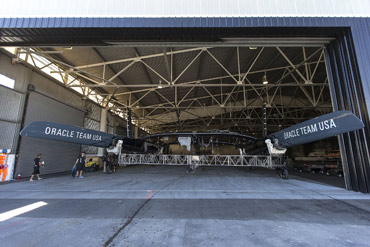 |
|
|
Oracle rolls the recovered platform into the shed for repair.
Photo:©2012 Guilain Grenier/Oracle Team USA |
Which puts the Oracle Team USA boatbuilding and shore teams on double duty, repairing the hulls of USA 17 and building a new wing while construction on the team’s second AC72 continues apace.
“Boat number two was well on its way, so only a small amount of the early days we got with this boat had a significant impact on what we did with boat number two. So at the moment, we’re fixing boat one and trying to go as quickly as possible. It’s mostly a question of getting the wing ready to put into it, as obviously the biggest damage was to the wing, which was in lots and lots of pieces. The hull mostly got damaged on the tow-in, with loose bits of wing banging into it, so there are a bunch of dents and bumps to fix up.
“Then we’ll take the opportunity to make a few changes we wanted to make anyway. We’ll take on as many modifications that we can afford to do until the wing is ready, such as changes to the platform layout. Then we’ll be ready to start sailing again, hopefully by the end of January or the beginning of February.”
With practical experience replacing theory, the design team will also make a few tweaks to the safety systems on the AC72 based on the hard evidence. One obvious goal is to make sure what went wrong in October doesn’t go wrong again.
“There are changes we’ll make to the boat, things that we didn’t do as well as we’d hoped and other things that worked fine that we won’t change,” Kramers said. “One thing that became more difficult than we thought it would be was keeping the boat head to wind. It was really difficult to attach lines to the boat and maneuver the boat relative to the wind effectively. We were never able to get lines to the top of the wing, which I think would have been helpful to maneuver the boat in the right direction. So we’re looking into ways to either float the tip of the wing up out of the water or getting a line attached to the top of the wing quickly and easily.”
Kramers is pretty matter-of-fact about how this experience stretches the team’s resources and personnel, as Oracle Team USA scrambles to get both boats ready for action early next year.
“The second boat is continuing on as planned; this
is just an additional build job that appeared on the floor here.”
--Diane Swintal for CupInfo/©2012
CupInfo.com
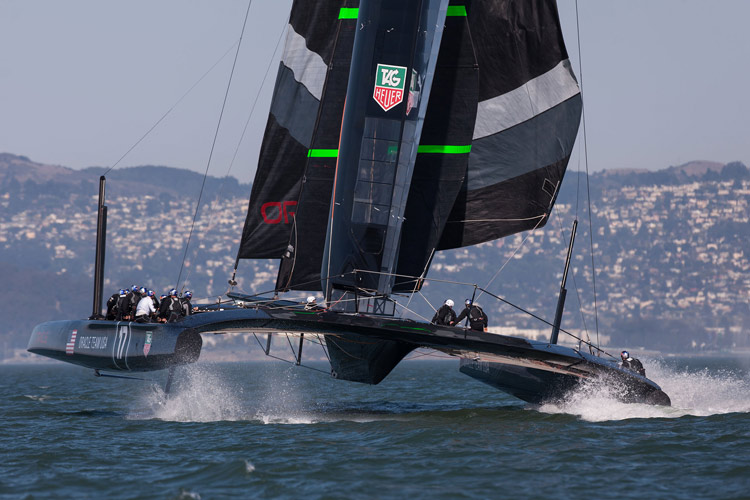
Oracle hopes to return 17 to the water in late January.
Photo:©2012 Guilain Grenier/Oracle Team USA
Links of Interest:
From CupInfo:
The Scary
Stuff: AC72 Capsize Risks and Precautions (Oct 16)
All Teams: AC72's in Development
Oracle Team USA AC72#1 Photos:
Day Eight Capsize
Sailing Days :
One |
Two
| Three
Articles On the Web:
From Michelle Slade:
Oracle's Brad Webb:
Onward and (Right Side) Upward at Sailing World (Nov 16)
From Dave Reed: ETNZ's Nick Holroyd:
Designed in the Matrix (Oct 19)